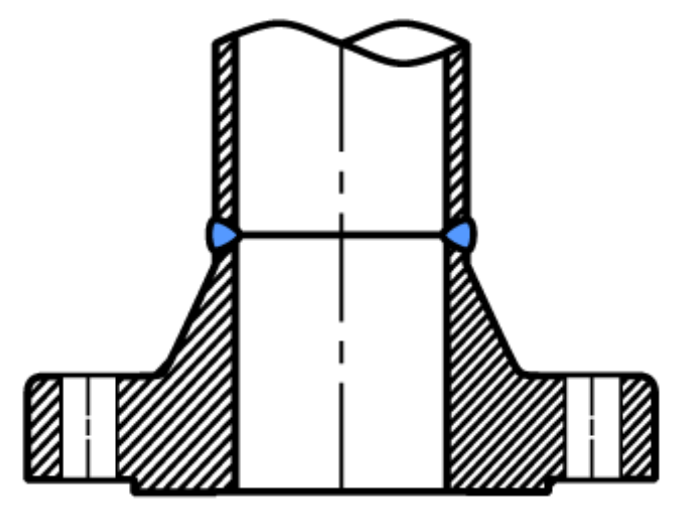Pipe Ends
At the end of any length of pipe, are the pipe ends. The most common pipe ends are:
- Plain End – for small pipe sizes (typically less than 2 inches (5cm)).
- Bevel End – for larger pipe sizes.
- Threaded End – for small pipe sizes (typically less than 2 inches (5cm)).
Plain End
A pipe with a plain end has the simplest of pipe ends. Plain end pipes are made by cutting a length of pipe at a 90-degree angle perpendicular to its length axis. Once the pipe has been cut, it can:
- Remain as it is i.e. remaining as a plain end pipe.
- Have the end cut at an angle to create a bevel end pipe.
- Have a thread cut onto it to create a threaded end pipe.
Flange Example
Socket weld flanges should use plain end piping. The below image shows a plain end pipe inserted into a socket weld flange; a fillet weld (highlighted blue) joins the pipe and flange.

Socket Weld Flange Joined to Plain End Pipe
Threaded End
A threaded end pipe has a thread cut into the pipe wall. The thread may be cut on the inside or outside of the pipe wall, thus a pipe may form the male or female part of a threaded joint. A pipe may have a left or right-hand thread, although left hand threads are much less common.

Left and Right-Hand Screw Thread
Unlike a plain end pipe, there are associated standards defining what the geometry of a thread should be for a given pipe size; standards exist for imperial and metric units. Typical screw thread nomenclature includes pitch, thread angle, depth, root, crest, minor diameter, pitch diameter and major diameter. When ordering a threaded end pipe, criteria such as the length of thread, thread angle, and thread form, are specified in the associated standard. If a male and female threaded end do not share complimentary geometry, it will not be possible to assemble them.

Thread Terminology
Threaded end pipe is only suitable for lower pressure and lower temperature systems, as the integrity of a threaded joint is not high. Any physical distortion (bending, flexing etc.) occurring on the pipe is likely to damage the integrity of the joint and cause leakage. For this reason, threaded end pipe is ill suited for usage on any system conveying poisonous fluids, and is not favoured for systems conveying flammable fluids.
Bevel End
Bevel end pipes are sometimes called ‘weld end’ or ‘butt weld end’ because they are cut with the intention of the ends being welded. A ‘bevel’ is any cut that is not perpendicular (90⁰) to the length orientation of the pipe. The standard bevel angle is 37.5⁰ although this can be varied.

Welding Neck Flange Joined to Bevel End Pipe
The above image shows a welding neck flange joined via a butt weld to a bevel end pipe (the weld is shown in blue).
Related Online Engineering Courses
Introduction to Steam, Boilers and Thermodynamics
Additional Resources
https://www.unifiedalloys.com/blog/pipe-ends
http://www.wermac.org/pipes/pipe_part3.html
https://blog.projectmaterials.com/pipes/pipe-ends-lengths
http://www.sunnysteel.com/pipe-end.php
